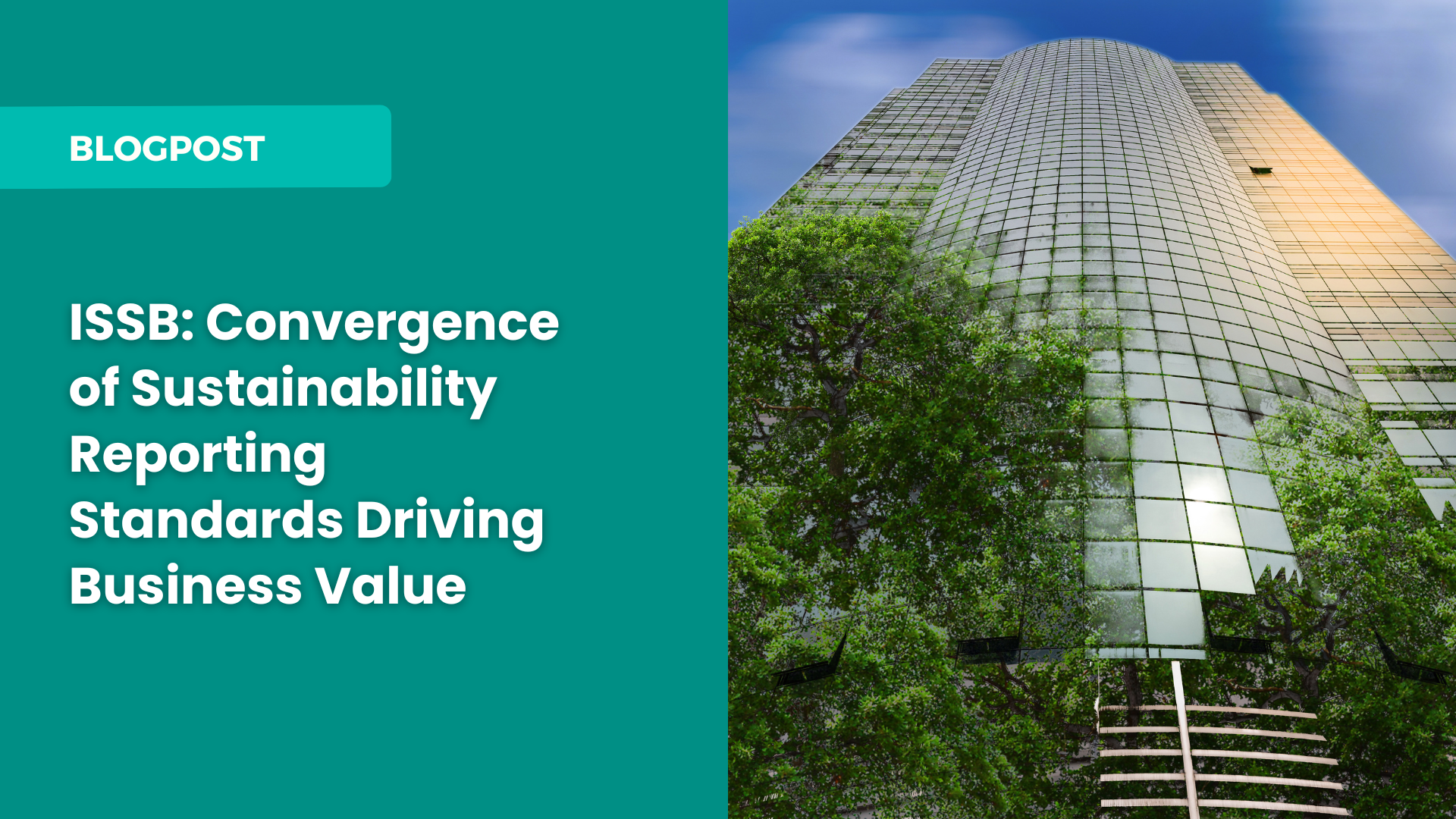Published 15 Aug 2025 –
For years, two fundamental questions have dominated boardroom conversations about Environmental, Social, and Governance (ESG) factors.
First: “Is there tangible financial value in pursuing a strong ESG strategy, or is it just a cost center?” And second: “With a confusing alphabet soup of sustainability reporting standards, how do we even begin to report our performance in a meaningful way?”
Within the last year, the business world has received stunningly clear answers to both.
The long, winding journey towards a coherent global standard for sustainability disclosure has culminated in the IFRS S1 and S2 (also known as ISSB Standards), creating a unified baseline for capital markets.
Simultaneously, detailed financial analysis from credible sources like Bloomberg has moved past correlation to confirm a powerful link: strong ESG performance is a clear driver of superior portfolio returns.
This is the ESG tipping point. The debate is shifting from “why” to “how.” The prize for getting it right is no longer theoretical, and the standards for measuring it are no longer voluntary.
For business leaders, this presents both the greatest strategic opportunity and the most significant operational challenge of the decade.
ESG as a Clear Driver of Financial Value
For a long time, the link between a company’s ESG score and its stock performance was the subject of academic debate. That debate is now being settled by data.
A recent, in-depth analysis by Bloomberg Professional Services, examining thousands of global companies from 2019 to 2024, delivered a clear verdict: portfolios with higher ESG scores consistently outperformed those with lower scores.
This wasn’t marginal. A long-short strategy — buying the top performers and selling the worst — generated significant alpha, confirming that ESG is far more than a feel-good metric.
The analysis further revealed that the Governance (“G”) pillar was the most powerful and consistent driver of this outperformance across all regions.
This makes intuitive sense: well-governed companies demonstrate superior risk management, operational excellence, and long-term strategic thinking, which are the universal hallmarks of a high-quality, resilient business.
This data reframes ESG entirely. It is no longer just a tool for values-based investing or risk mitigation; it is a clear indicator of operational quality and a driver of enterprise value.
The message to boards and investors is unequivocal: good ESG is good business. This reality raises the stakes immensely, transforming the act of disclosure from a communications exercise into a core component of value creation.
Navigating the Convergence of Sustainability Reporting Standards

ESGpedia supports a wide range of international and local sustainability reporting standards – digitally integrated onto the platform – to address businesses’ unique needs while helping them align with the global convergence towards ISSB Standards.
Explore Sustainability Reporting Standards here: https://esgpedia.io/platform-nexus/sustainability-reporting/
The establishment of the ISSB in November 2021 marked the beginning of the end for the “alphabet soup” of standards (GRI, SASB, TCFD) that left many business leaders frustrated and viewing the effort as a “waste of time.”
Today, this convergence around the IFRS S1 and S2 (ISSB) standards is creating a global baseline, with pioneering jurisdictions like Hong Kong, Japan, and Malaysia leading Asia in fully aligning with ISSB Standards, and Singapore mandating their adoption starting with large, listed companies.
This is a welcome development for investors who crave comparable, decision-useful information. However, for the companies and boards responsible for the reporting, it presents a new and formidable gauntlet of challenges.
The shift from voluntary to mandatory reporting demands a completely new level of rigor and expertise. As highlighted in a recent analysis in The Business Times, directors are now grappling with highly technical requirements.
IFRS S2, for example, requires companies to disclose not just qualitative commentary on climate-related risks, but also the quantitative financial impacts of those risks on their balance sheet.
This is a monumental task. The methodologies for modeling long-term climate scenarios are nascent, and the process requires a level of integration between the finance and sustainability functions that most organisations are simply not structured for.
This is the new operational reality: producing a report is no longer enough. Companies must now produce data that is credible, auditable, and directly linked to financial statements. The challenge has moved from storytelling to sophisticated data management.
From Data Chaos to Strategic Capability
The answer lies in a fundamental mindset shift: treating non-financial data with the same seriousness and rigor as financial data.
The silo between the Chief Financial Officer and the Chief Sustainability Officer must be broken down, and this requires a unified data infrastructure to serve as the foundation.
Attempting to manage this new reality with disconnected spreadsheets and manual processes is a recipe for failure. It is inefficient, prone to error, and cannot provide the auditable, investor-grade data that both regulators and capital markets now demand.
The solution is inherently technological. Success in this new era requires a central platform that can:
- Automate Complex GHG Calculations: Ingest operational data such as utility bills and supply chain logistics, as well as automatically calculate complex metrics like a full carbon footprint and the quantified financial risks of climate change.
- Harmonise Multiple Frameworks: Map a single set of data across multiple reporting frameworks — from the IFRS S1 and S2 (ISSB Standard)’s single-materiality approach for investors to the GRI Standard’s double-materiality approach for broader stakeholders — eliminating duplicative work.
- Create a Verifiable Audit Trail: Log every data point digitally, creating a single source of truth that can be easily reviewed by management and, crucially, handed over to third-party assurers for verification.
Building this strategic capability allows companies to transform ESG from a burdensome compliance exercise into a powerful business intelligence function.
The same data used for the ISSB-aligned report can reveal operational inefficiencies, identify energy cost savings, and de-risk the supply chain.
The Dawn of the ESG-Integrated Enterprise
The most successful and valuable companies of the coming decade will be those that erase the line between their business strategy and their sustainability strategy.
They will be ESG-integrated enterprises, driven by a unified stream of financial and non-financial data that informs every decision, from capital allocation to product development.
They will not see ESG as something they have to do, but as a core part of how they win. The superior returns identified by Bloomberg will not be a surprise to them; it will be the expected outcome of a well-run, resilient, and forward-looking business.
The path is challenging, but the destination is clear. The time to build this capability is now.
Easily Kickstart ISSB-aligned Sustainability Reporting with ESGpedia
Is your business equipped to turn the complexity of latest disclosure standards into a driver of financial value? ESGpedia provides the digital platform and tools to help you generate a credible Sustainability Report and build a robust, investor-grade corporate sustainability strategy.
Get in touch to kickstart your sustainability reporting in accordance with international sustainability reporting standards like IFRS S1 and S2 (also known as ISSB), GRI, and more.




